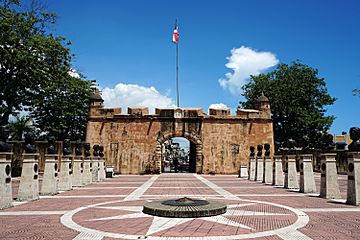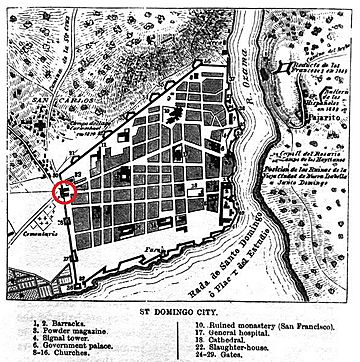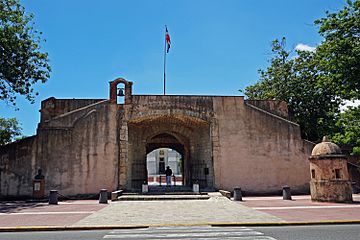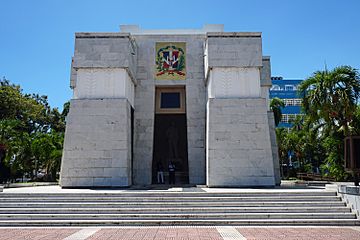Puerta del Conde facts for kids
| UNESCO World Heritage Site | |
|---|---|
 |
|
| Location | Santo Domingo, Dominican Republic |
| Part of | Colonial City of Santo Domingo |
| Criteria | Cultural: (ii), (iv), (vi) |
| Inscription | 1990 (14th Session) |

La Puerta del Conde (which means The Count's Gate) was once the main entrance to the old, fortified city of Santo Domingo. This city is now part of the Dominican Republic. The gate was named to honor Governor Captain-General Bernardino de Meneses Bracamonte y Zapata, 1st Count of Peñalva. He bravely defended the city from an attack in 1655. This attack was led by English General Robert Venables and Admiral William Penn during a war between England and Spain.
The gate is part of a larger structure called El Baluarte del Conde (The Count's Bulwark). This bulwark is a fort located in Ciudad Colonial, the historic colonial area of Santo Domingo. The fort was part of a big system of walls that protected the entire old city. Today, you can find the Altar of the Fatherland and Independence Park right here.
It was at this very spot that Francisco del Rosario Sánchez, one of the Dominican Founding Fathers, declared Dominican independence. He also raised the first Dominican Flag here on February 27, 1844.
Contents
History of the Count's Gate
Building the Fort and Walls
Construction of this important site began in 1543. It was first known as Fort San Genaro. Its main purpose was to protect Santo Domingo from invading armies and attacks by pirates.
The city's defensive wall, called a muralla, was changed in 1655. This happened after the English, led by William Penn and Robert Venables, tried to take over Santo Domingo. Spanish troops, led by Captain General Don Bernardino de Meneses y Bracamonte, the Count of Peñalva, stopped the invasion. Because of his courage, the site was named La Puerta del Conde in his honor. The wall was connected to Fort San Genaro, and over time, they became one structure, known as La Puerta del Conde since 1655.
El Baluarte del Conde is a great example of 17th-century fortresses. These forts were built with an Italian style and are still important historical sites in the Caribbean. The city's defensive wall was fully built by the 18th century. It surrounded Colonial Santo Domingo in a five-sided shape. La Puerta del Conde was the main entrance on the western side of the old city. Not much of the original wall remains today. However, you can still see parts of it with gates and forts, like La Puerta del Conde, La Puerta de la Misericordia, Fuerte San Jose, Fuerte Santa Barbara, and Fuerte San Gil.
The Count's Gate Today
Today, La Puerta del Conde is the main entrance to El Parque Nacional (The National Park), also known as Independence Park. Above the arch of La Puerta del Conde, there's a Latin phrase: "ỉDulce et Decori est pro patria moriḯ". This means "It is indeed sweet and honorable to die for the fatherland." El Baluarte del Conde is a powerful symbol of independence. It holds several monuments that show the Dominican people's fight for freedom. People often call the fort La Puerta del Conde/Parque Nacional because they are both very important symbols of the Dominican Republic. The park is also where the Altar de la Patria (the Altar of the Fatherland) is located.
Independence Park: A Historic Place
El Parque Independencia (Independence Park) is a historic park located within El Baluarte del Conde. It's named this way because it's where Dominican independence was declared in 1844. The Altar de la Patria (see below) is also found in the park. Today, Parque Independencia is bordered by a section of the original defensive wall, La Puerta del Conde. In 1912, architect Antonin Nechodoma redesigned the park to look as it does now. A street that used to pass through the park was removed. This redesign later made it easier to build the Altar de la Patria.
Altar of the Fatherland: Honoring Heroes
The Altar de la Patria, or Altar of the Fatherland, is a special monument built in 1976. It is made of beautiful white marble. This altar holds the remains of the three founding fathers of the Dominican Republic: Juan Pablo Duarte, Francisco del Rosario Sánchez, and Matías Ramón Mella. Inside the monument, you can see statues of these heroes, carved by an Italian artist named Nicholas Arrighini. There is also an "eternal flame" that stays lit to remember these important patriots.
See also
 In Spanish: Baluarte del Conde para niños
In Spanish: Baluarte del Conde para niños



